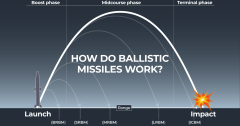In response to Israeli attacks on its nuclear sites and senior military figures, Iran has launched hundreds of ballistic missiles towards Israel, with some striking targets on the ground.
Although Israel intercepted many of the incoming missiles, several breached its defences, causing significant damage and casualties, including hits on central Tel Aviv and other areas.
The exact size of Iran’s ballistic missile arsenal is unclear, but it is widely considered one of the largest and most advanced in the region.
In the following visual explainer, Al Jazeera unpacks how ballistic missiles work and how they are being used in the ongoing conflict.
How do ballistic missiles work?
Ballistic missiles are long-range weapons designed to deliver conventional or nuclear warheads by following a ballistic, or curved, trajectory.
Launched using powerful rocket engines, these missiles shoot upwards into the upper atmosphere or even space, travelling at incredibly high speeds. Once their engines are cut off, the missile follows a predetermined path, re-entering the Earth’s atmosphere in a steep descent before striking its target.

How far can they travel?
Ballistic missiles can travel distances ranging from a few hundred kilometres to more than 10,000 kilometres across continents.
Ballistic missiles are classified based on their ranges:
- Battlefield range ballistic missile (BRBM) – less than 200km (124 miles)
- Short-range ballistic missile (SRBM) – less than 1,000km (621 miles)
- Medium/Intermediate-range ballistic missile (MRBM/IRBM) – between 1,000km and 3,500km (621-2,175 miles)
- Long-range ballistic missile (LRBM) – between 3,500km and 5,500km (2,175-3,418 miles)
- Intercontinental ballistic missile (ICBM) – greater than 5,500km (3,418 miles)
What speeds can they reach?
Ballistic missiles travel at extremely high speeds, allowing them to travel thousands of kilometres in just minutes.
The speed at which they travel is measured in Mach, a unit equivalent to the speed of sound; for example, Mach 5 means five times the speed of sound.
Some, usually shorter-range, ballistic missiles reach supersonic speeds (faster than Mach 1, or about 1,225km/h or 761 miles per hour), while others, usually longer-range missiles, can travel at hypersonic speeds – greater than Mach 5 (6,125km/h or 3,806mph).

How long does it take for Iran’s missiles to reach Israel?
The distance between Iran and Israel is about 1,300km to 1,500km (800-930 miles). Ballistic missiles from Iran travelling at Mach 5 can reach Israel in roughly 12 minutes, though the exact time depends on the missile type and the launch site.
Why are ballistic missiles hard to intercept?
What makes ballistic missiles especially dangerous is their combination of long range, high speed, and how difficult they are to intercept.
Their fast, high flight path gives defence systems little time to react, and when they re-enter the atmosphere, they descend even faster, making interception even more difficult. Some missiles also deploy decoys or other countermeasures to trick radar and missile defences, making them harder to intercept.
What is the difference between ballistic and cruise missiles?
Iran has also used cruise missiles against Israel. Unlike ballistic missiles, cruise missiles fly low and steady like pilotless pla





